Mesoamerica AD 300 to 1521
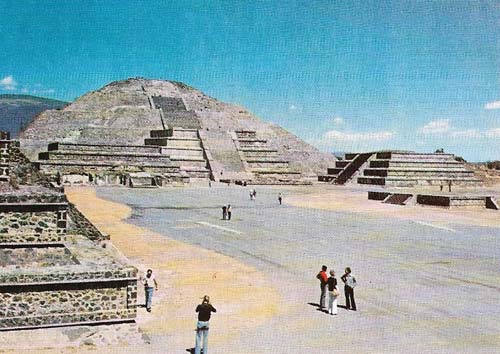
Figure 1. The Pyramid of the Moon at Teotihuacan is one of two massive structures that dominate the heart of this great city, the first major planned settlement on Mesoamerica. It flourished from about 100 BC until AD 700 in a small valley branching off from the Valley of Mexico. The pyramid and the great plaza in front close the northern end of the Street of the Dead.
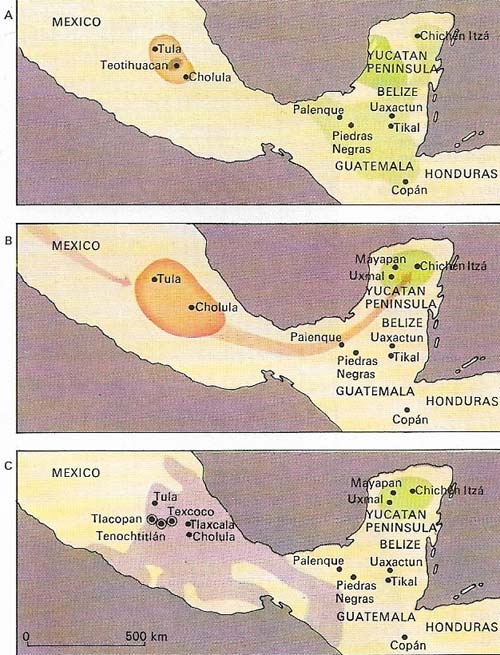
Figure 2. There were three stages in the prehistory of Mesoamerica. (A) The cities of Teotihuacan and Cholula dominated highland Mexico (AD 500). (B) Toltec influence from Tula reached Chichen Itza in the Maya lowlands. The Maya civilization began to collapse in about AD 1000. (C) The Aztecs ruled the highlands, and the Yucatan Maya sites were eventually abandoned (AD 1500).
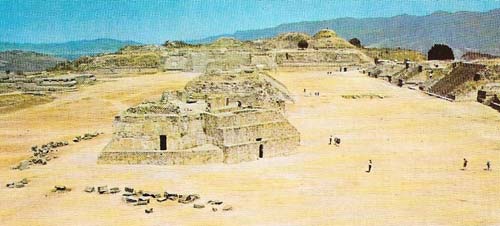
Figure 3. The Great Plaza forms the core of the main Zapotec ceremonial center of Monte Alban, on the hills overlooking the Valley of Oaxaca. The building on the foreground, Mound J, lies on a different orientation from the rest of the site, and has been identified as an astronomical observatory; it is also adorned with carved panels depicting the towns conquered by the lords of Monte Alban. A large population lived nearby.
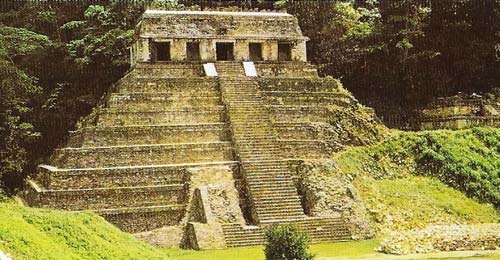
Figure 4. Famous for its stucco sculptures is the temple at the western lowland Maya site of Palenque. This was one of the first Maya sites to be explored on the eighteenth and nineteenth centuries, and work has continues there since. The most spectacular discovery came in 1952 when a stairway was found leading to a buried vault where a great stone sarcophagus contained the jade-laden body of a ruler. Recent study of the hieroglyphic tablets that give this Temple of the Inscriptions its name identify him as Pacal, first and greatest ruler of Palenque.
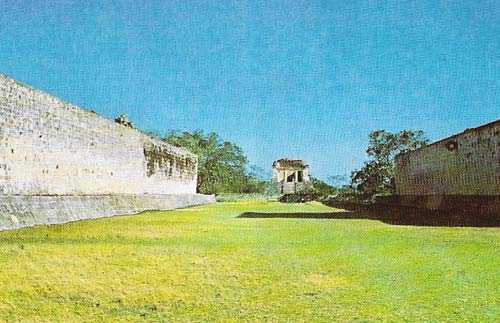
Figure 5. The Great Ball-court at Chichen Itza was the largest in Mesoamerica. This huge structure, about 83 meters (270 feet) long, was erected by the Toltec conquerors of Yucatan in AD 1000. Stone rings in each wall were targets for the ball and sculptures along the base of the walls depict the decapitation of a ball-player, perhaps the captain of the losing team. A small temple stands at the end.
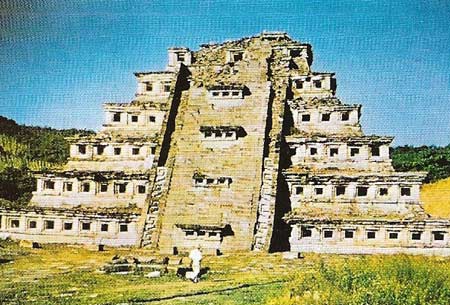
Figure 6. The Pyramid of the Niches at El Tajin is a large ceremonial center on the Gulf of Mexico and one of the best-known sites of the Classic Veracruz civilization. It flourished through the first millennium AD contemporary with the Maya to the southeast and Teotihuacan to the south. There are 365 niches on the pyramid which have been interpreted as reflecting the days of the solar year in another aspect of the Mesoamerican obsession with the calendar and the passage of time. El Tajin also had a number of ball-courts, decorated with sculptures showing sacrifice, possibly of an earlier date than Chichen Itza.
During the greater part of the first 1,500 years after the birth of Christ there was a definable "Mesoamerican" civilization. This term was coined by the scholar Paul Kirchhoff in 1943 to describe the very similar cultures that occupied what are now southern Mexico, Belize, Guatemala, Honduras and El Salvador, extending eastwards through Nicaragua into Costa Rica between AD 1000 and 1500. These cultures shared temple-pyramids as religious centres; the sacred ball-game called pok-ta-pok by the Maya and tlachtli by the Aztec; a pantheon of deities including sun, wind and rain gods; and in the latter part of the period, especially, an iconography with a grisly emphasis on death.
Classic and Preclassic cultures
Many of these features had first appeared in the Preclassic cultures, and in the succeeding Postclassic period (from AD 900 to the Spanish Conquest in 1519) they reached their most complex form and widest distribution. The first of the Classic cultures to attain great importance was that of Teotihuacan, based on the great city of that name in the Valley of Mexico. From AD 300–600 the city was at its maximum size, estimated to have contained about 200,000 people.
One of the surrounding cultures was that of the Maya. These people occupied the Yucatan Peninsula and the adjacent highlands of Guatemala and their area can be divided into three contrasting regions: the southern, consisting of the volcanic highlands and the short steep slope down to the Pacific shore; the northern, the arid scrub plateau of northern Yucatan; and the central, the jungle-filled basins of the Usumacinta, Belize and Hondo rivers. It was in this central area, that Classic Maya civilization emerged and flourished.
The appearance of this civilization is defined by the erection of stone stelae (upright slabs) with inscriptions in the complex calendar known as the Long Count, which combined three different calendars in one; by the building of massive stone temples and other public buildings in civic and religious complexes normally described as "ceremonial centers"; and by beautifully decorated polychrome pottery in new forms.
Oaxaca, a highland valley in southern Mexico, has one of the longest histories in Mesoamerica. The apogee of the culture of the Zapotec Indians who lived there came between AD 300 and 600 and was focused on the great hilltop city and ceremonial centre of Monte Alban (Figure 3).
The site has one enormous plaza laid out by levelling the hilltop, lined on all four sides by large buildings approached by broad sweeps of steps. The working of precious stones and metals was one of the most no-table characteristics of the Zapotec and of their successors as rulers of Oaxaca, the Mixtec. After Classic Monte Alban was abandoned in the 7th century, some of the tombs were re-used by the Mixtec nobility. Mixtec expertise also extended to architecture and their capital at Mitla has walls decorated with long, repetitive mosaics, of thousands of rectangular pieces of stone.
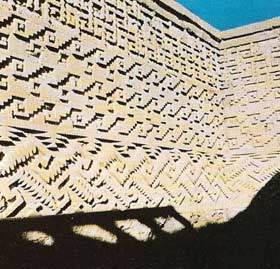 |
| A room in the Mixtec palace at Mitla shows the complex stone mosaic decoration based mainly on the step-fret motif and built up of thousands of individually shaped stone blocks. The rooms, which were roofed in timber, lie round a series of closed courtyards accessible through narrow passages, there is also a pillared hall and tombs that lie below courtyard level. |
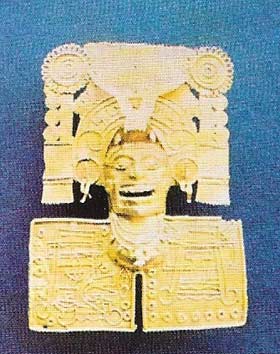 |
| This head is one of superb pieces of Mixtec gold work discovered in 1932 in the excavation of Tomb 7 at Monte Alban. This was a Zapotec tomb of an earlier period that had been reused for the burial of a Mixtec lord. The tomb also contained carved bones, rock crystal, turquoise, mosaics, and jades, this piece was probably worn on the chest and reveals a complex symbolism. The gold-working technique came from South America. |
The Gulf Coast
No such spectacular manifestation of architectural brilliance existed along the Gulf Coast, the home of the Olmec. But the cultures of Veracruz, and to the north that of the Huasteca, had their own distinctive characteristics. Veracruz sculpture was marked by panels filled with complex designs, many of them concerned with sacrifice, the ball-game, or both. The best-known site is El Tajin (Figure 6), where five ball-courts have been uncovered. These panels are close in conception to those on the great ball-court of Chichdn Itzg in Yucatan.
Chichdn Itza is a Maya site in origin. Its most spectacular ruins mark the occupation of Chichdn and the domination of northern Yucatan by the Toltec, a warrior people from highland Mexico north of Mexico City. Many of the buildings at Chichen are derived from the architecture of the Toltec capital Tula. The most spectacular are the Castillo, a massive temple-pyramid with steps on all four sides, the Temple of the Warriors, and the tzompantli or skull-rack, where the heads of sacrificed victims were displayed (Figure 5).
The most impressive feature of the site is natural – the great circular Cenote (well) of Sacrifice, more than 18m (60 ft) deep, into which victims were flung to bring rain.
The civilization of the Aztec was in full flower when it was destroyed by the European invaders and was the only Mesoamerican high culture to be observed and recorded as a living entity.
The cities of the Aztec
The Aztec had taken Teotihuacan (Figure 1) and Tula as models in making the central high-lands of Mexico their base and like them had extended their way down into the coastal lowlands. Their capital, Tenochtitlan, was sited on islands in Lake Texcoco and had a population estimated at 300,000. It comprised two cities, the second being Tlatelolco to the north of Tenochtitlan, which acted as the commercial centre. Part of the marketplace and temples of this city have been excavated and restored, whereas the major part was demolished by the Spaniards during the conquest; the centre of the colonial capital was built on its ruins. Most of what remains of Aztec culture consists of grim lava sculpture, delicate turquoise mosaic work, and a number of manuscripts in picture writing, often with marginal notes in European script.
